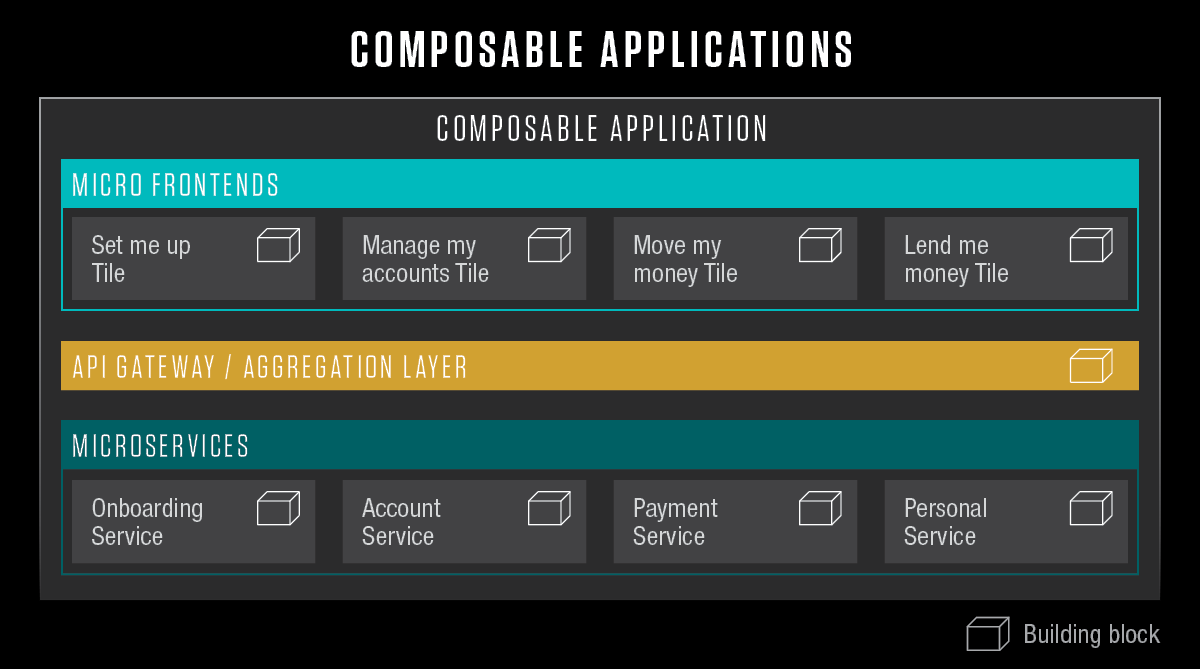Businesses must evolve and innovate rapidly to keep up with customer needs, and accordingly are adopting strategies that remove technical hurdles and effort when implementing and ‘plumbing in’ the necessary underlying capabilities. One compelling strategy is to adopt composable applications that enable an iterative, modular approach for the smoother and more efficient implementation and rollout of new features and experiences.
Gartner predicts that by the end of 2023 organisations that embrace composability will outpace the competition by 80% when it comes to timelines for implementing new product features. So, the time is now to start your composable journey to avoid the risk of being left behind.
Defining composable applications
A composable application approach enables the rapid development of applications by assembling reusable functional blocks. Each block encapsulates a business capability and is reconfigured and reassembled to serve multiple business areas and provide varying customer experiences. A block is a logical construct with a various possibilities of implementations – for example, a micro frontend, a microservice, a bundled frontend and backend, and so forth.
Each block has the following properties:
- Independently scalable – It is possible to scale up or down independent of other functional blocks within the application.
- Evolve with market needs – The functionality encapsulated in each block is updatable without impacting other blocks, unless there is a change in the contract between the two blocks.
- Designed to be autonomous – Each block is self-governing, self-monitoring and takes full responsibility of the underlying functional capability that it implements.

The diagram above shows an example of composable architecture. Each micro frontend tile, microservice, or aggregation layer is a decoupled block that can be plugged in, plugged out, updated, or replaced independently to keep pace with business requirements.
Enablers for a modern architecture
Implementing this approach is a logical and complementary step for a business adopting modern architecture practices. Some examples of initiatives that marry well with the composable applications approach include:
• Microservices and micro frontends – These architectural choices for implementing the application backend and frontend creates the functional blocks (as individual microservice or micro frontend), that act as the building blocks for the composable applications.
• Multi-cloud – As each functional block is independent and decoupled from other functional blocks and only bounded through APIs, it is possible to adopt different infrastructure choices for each block. In some cases, adopting redundancy throughhaving multiple block deployments across different cloud providers makesmake sense as a fail-safe strategy.
• Infrastructure-as-code – This approach enables the automatic provisioning of the technology stack for each functional block through code, providing a powerful mechanism for faster redeployments and reconfigurations.
• Configurable multi-channel user experience – Each functional block is independently configurable, which makes it possible to offer multiple variations of user experience targeting different channels.
No significant change is required in terms of the overall tech strategy, as all these initiatives are the precursor for composable applications. From an architecture perspective, the enablers for this approach are the APIs that connect the fragmented pieces of more significant, more intricate components to make them composable. Other considerations include modularity, autonomy, discoverability, and orchestration approach.
Harvesting the value
Business benefits of composable applications include:
• Fast turnaround - Improved time to market as the impact of changes will be limited to the scope of the domain and avoids extensive regression testing cycles.
• Easy growth - Ability to rapidly scale as it enables workstream parallelisation.
• Robustness - Resilience in the face of uncertainty as it limits the blast radius of a failure.
Furthermore, composable applications are an enabler of agile ways of working because it allows functional teams to own their domains in a loosely coupled manner.
To sum up
Businesses should start endorsing composable applications as an essential strategic approach to strengthen their competitive position. It should be a manageable choice for most CTOs, as it aligns well with their existing tech strategy and roadmap of implementing modern architecture practices.
We hope that you have enjoyed reading this installment of Capco’s 2023 Tech Trends series. Written by our in-house practitioners, the series covers composable applications, cybersecurity mesh, data fabrics and autonomic systems – topics that are both relevant and additive when addressing a number of the key business and technology challenges that the financial services industry is now facing.





